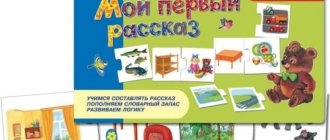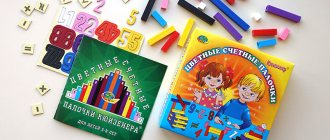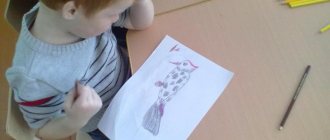Open lesson in the middle group on speech development “Writing a fairy tale.”
Open lesson in the middle group on speech development.
"Let's make up a fairy tale." Goal:
together with the children, compose a moral and meaningful fairy tale.
Objectives:
Educational: - Learn to compose a fairy tale using the modeling method. — Teach children to answer in full sentences, activate their vocabulary. Developmental: - Develop figurative perception and associations with the help of multi-colored geometric shapes (modeling method). — To develop children’s creative abilities (imagination, thinking, logic, ability to reason, draw conclusions) in inventing a fairy tale plot. — Develop conversational speech in children: teach children to select the right words, answer questions, speak coherently and expressively; activate the words in children's speech: keeper, casket, jewelry, tight. Educational: - To cultivate moral qualities: attentiveness, kindness, responsiveness, care, the desire to become physically strong in order to help the weak. — Foster a sense of collectivism and cohesion. Methods and techniques: problem-search, game, modeling, conversation, visualization, reflection. Materials for the lesson: * flannelgraph
* geometric shapes: green triangles of different sizes, white circle, orange triangle, gray rectangle, brown square)
* audio recording (hare, fox, wolf, bear, sounds of a magic casket, ringing bells, “Again a fairy tale is knocking on our door,” Nikitin’s “Song about a fairy tale”) * casket. * books of fairy tales as gifts for children, envelopes with wishes.
Progress of GCD: Organizational moment: (the sounds of bells are heard)
—
It is a very good tradition to wish everyone good health in the morning with a wonderful word: “Hello!” Let's greet each other.
To be polite,
You need to say “hello”
To everyone who I meet -
Children know this.
You say “hello” and in response
It will sound: “Hello, hello!”
The audio recording “Again, a fairy tale is knocking on our door” is played.
-Children live in a certain kingdom, in a certain state. They love fairy tales very much...
-Do you know these children? Then let's close our eyes, turn around ourselves three times and be transported to a fairy-tale kingdom-state.
A magical sound of transformation is heard and a teacher enters the children - this is the keeper of the fairy-tale casket. Guardian:
Hello guys!
I am the keeper of a fairytale casket. Wherever I have been, Whatever I have heard. I have visited all the unheard of, I have seen all the unheard of. She collected all the fairy tales, put them in a chest and kept them in it, took care of them. - Guys, do you know what a casket is? (Give children the opportunity to answer independently, and then summarize) A casket is a beautifully hand-made, decorated box for storing jewelry. (The teacher leads the children to the exhibition of boxes.) - What are jewels? (Children answer) You are right - these can be beautiful stones, gold, and pearls. But fairy tales, guys, are more valuable than any gold, fairy tales are folk wisdom, they are a real treasure. After all, life without fairy tales would be very boring and sad; fairy tales teach us to be kind and brave, strong and skillful. But then trouble came! The evil Baba Yaga stole fairy tales from a fairytale casket and cast a witchcraft spell on the casket - only then will the fairy tales return to the casket if you guys, together with me, compose a good fairy tale. So I came to you for help. Help me return fairy tales to all the kids. Children:
Okay, we will help you return the fairy tales to the box. With the help of a magic ball, children find a fairy chest.
Guardian:
- Guys, let's look into the chest and see if Baba Yaga left some clues.
(To the sound of a magic box, the children look into the casket and find geometric shapes there). What do you think this is? (children answer). What are these figures? (children's answers) Guardian:
- Guys, what do you think these green triangles of different sizes look like? Children express their guesses. (If the children find it difficult, the teacher gives a hint: in winter and summer - one color) Children answer and lay out four Christmas trees made of two, three, four and five triangles on a flannelgraph. -How many Christmas trees are there? (4), show me the tallest Christmas tree, let’s count how many triangles there are, now show me the lowest Christmas tree and count how many triangles there are? And where are there a lot of Christmas trees? (children's answers) Correct. In the forest. So we have a fairy-tale forest in which our fairy tale will take place. Which forest inhabitants do you know? (Children list: hare, wolf, fox, bear, etc.) (To the sound of a magic box, children look into the casket and find geometric figures there). Guys, what are these multi-colored figures? Who might they look like in our fairytale forest? Children express their guesses. I think so too, probably these are animals. Let's determine who these animals are. Showing the white oval. Guys, who do you think this is? Children express their guesses. (If the children find it difficult, the teacher gives a riddle hint: white in winter, gray in summer; loves carrots, jumps deftly; long ear, short tail). That's right, guys - it's a bunny. Guys, what is a bunny called in fairy tales? (Children's answers: a bunny is a coward, a bunny is a runaway, a bunny is a jumper) Guys, what should we call the bunny in our fairy tale? (Children answer) Okay. Our bunny will be called - Bunny - Jumping. Let's show how the bunny jumps. (Children pretend to be a bunny to the music) Let the bunny live under our small Christmas tree. (The child places a white circle near a small Christmas tree) Showing an orange triangle. Guys, who do you think this is? Children express their guesses. (If the children find it difficult, the teacher gives a hint: a cunning cheat, a red head, a fluffy tail - who is it?) That's right, it's a fox. Guys, what do they call a fox in fairy tales? (Children's answers: fox - beauty, fox - sister, fox - cheating, godfather, fox - red tail). Guys, what will we call the fox in our fairy tale, what name will we give her? (Children answer) Okay. Let her name be Fox - red tail. Let's show how a fox walks. (Children pretend to be a fox to the music) And let the fox - Red Tail - live under the Christmas tree higher up. (The child places an orange triangle near a larger Christmas tree) Showing a gray rectangle. Who could it be, guys? Children express their guesses. (If the children find it difficult, then the teacher gives a hint: in the cold winter, angry and hungry wanders in the forest) That's right, it's a wolf. Guys, what is a wolf called in fairy tales? (Children's answers: gray wolf, wolf - gray tail, wolf - click with teeth, gray robber). What should we call the wolf in our fairy tale? Fine. Let his name be Wolf - Click his teeth. Let's show how a wolf prowls. (To the music, children pretend to be a wolf) Let the wolf live under the Christmas tree even higher. (The child lays out a gray rectangle under the Christmas tree) Showing a brown square: Who could it be, guys? Children express their guesses. (If the children are at a loss, the teacher gives a hint: he loves berries and honey, he lives in a den in winter, he’s cute, isn’t he? A shaggy lump...) That’s right, it’s a bear. Guys, what do they say about a bear in fairy tales? (children's answers: Teddy bear, Mikhailo Potapovich, little bear). What do we call the bear from our fairy tale? Fine. Let it be Mikhailo Potapovich. Let's show how a bear wanders. (Children pretend to be a bear to the music) And what kind of tree will the bear live under? And let the bear live under the tallest tree. (The child places a brown square under the largest tree)
Guardian:
Well, now sit down next to each other and write a fairy tale.
What words do many fairy tales begin with? That’s right, “Once upon a time...” Guardian:
So let’s begin our fairy tale as well.
“Once upon a time there were animals in the same forest: a bunny - Jumping, a fox - Red Tail, a wolf - Click with Teeth and a bear - Mikhailo Potapovich. One day a small (white oval) bunny went for a walk in the forest. Guys, what do you think the bunny was doing in the forest? Bunny - Bunny jumped merrily, jumped through the snowdrifts, admired the sun. Suddenly a fox runs out from behind the tree to meet him (showing an orange triangle). Bunny - The little runner got scared and rushed away from the Fox - Red Tail, running as fast as he could. And then a big and scary (showing a gray rectangle) wolf jumps out from behind another tree. Bunny-Runner was at a loss, there was nowhere for him poor thing to run. Behind the Fox - Red tail, in front the Wolf - Clicking teeth. The bunny trembled - Runner, what should he do, what should he do? Children suggest: call for help, hide, run left or right, run to your friend the bear for help. Then the bunny remembered his friend (show the brown square, place the brown one near the largest tree) the bear, who lived under the largest tree. And he ran to the right to his friend. And the Fox - Red Tail and the Wolf - clicking their teeth, run after the Bunny - Runner and swear loudly: “Don’t touch, this is my prey!”, “No, this is my prey!” They made so much noise that they woke up Mikhail Potapovich. - R-rr-r-r-r! - said the bear. “Who’s that noise here that’s keeping me from sleeping?” What do you guys think the bunny answered? (Children's answers) - Hello, Mikhailo Potapovich! It’s a fox and a wolf who are chasing me, please help me,” the bunny cried. How the bear stomped his feet, how he threatened with his paws, how he growled in a stern voice: “Get out, I’ll get you out of the way, and as soon as I jump out, the pieces will go down the back streets.” Let's, guys, help the bear drive away the wolf and the fox - stomp our feet, shake our fists, growl in a loud voice: - R-rr-r-r-r-r (phonetic exercise). What do you guys think happened next? Right. The fox and wolf got scared and ran away. I think we've written a fairy tale. And every fairy tale ends with the words: They began to live, prosper and make good. That’s the end of the fairy tale, and whoever listened – well done! Questions for consolidation: - Who did you like best in our fairy tale? — What would you advise a bunny to make him strong and big? — Guys, who wouldn’t you like to be like? Why? - Guys, do you think our fairy tale ended well? (But why? - Would you like to have a friend like a bear? Why? - And, you know, how people say about such friendship: “It’s hard to live without a friend.” The keeper invites the children to act out the fairy tale they have written
.
On the stage there is a forest of fir trees, and children are wearing hats with geometric shapes on their heads. — Was our fairy tale good or evil? Why? So, we have fulfilled Baba Yaga's condition? Then, let's check the fairytale chest to see if the fairy tales have returned to it. (To the sounds of the Nikitins’ song “Song of a Fairy Tale”) The children, together with the keeper, go to the casket and find in it an envelope with fairy tales and an assignment: “Guys, in the evening, be sure to draw our fairy-tale heroes, and bring your drawings to the kindergarten, we will send them to our fairy forest. Read and take care of fairy tales..” Guardian:
Thank you very much, guys, for your help! And now, guys, it's time for me to say goodbye to you. Goodbye.
Summary of a lesson on speech development in the middle group “Once upon a time there were fairy tales”
Nadezhda Zonova
Summary of a lesson on speech development in the middle group “Once upon a time there were fairy tales”
Goal: to develop children’s cognitive and speech skills using the example of their favorite fairy tales .
— To consolidate children’s knowledge about Russian folk tales .
— Continue to develop coherent speech , correctly coordinate words in a sentence.
— Develop attention , memory, logical thinking, creative imagination.
— Enrich children’s vocabulary with the words: “fidget”
,
“fidgety”
,
“minx”
,
“lazy”
,
“fluffy”
,
“nimble”
, etc.
— Cultivate interest in Russian folk tales
1. Look at illustrations for fairy tales .
2. Making riddles about fairy tales .
4. Screening of the fairy tale “The Three Bears”
(Tabletop theater)
.
2. Verbal: artistic expression, conversation, asking riddles, telling a story , reading poetry, asking questions to children.
3.Game: surprise moment.
Magic box, music "Magic Flower"
, tape recorder, chart cards, multimedia projector





